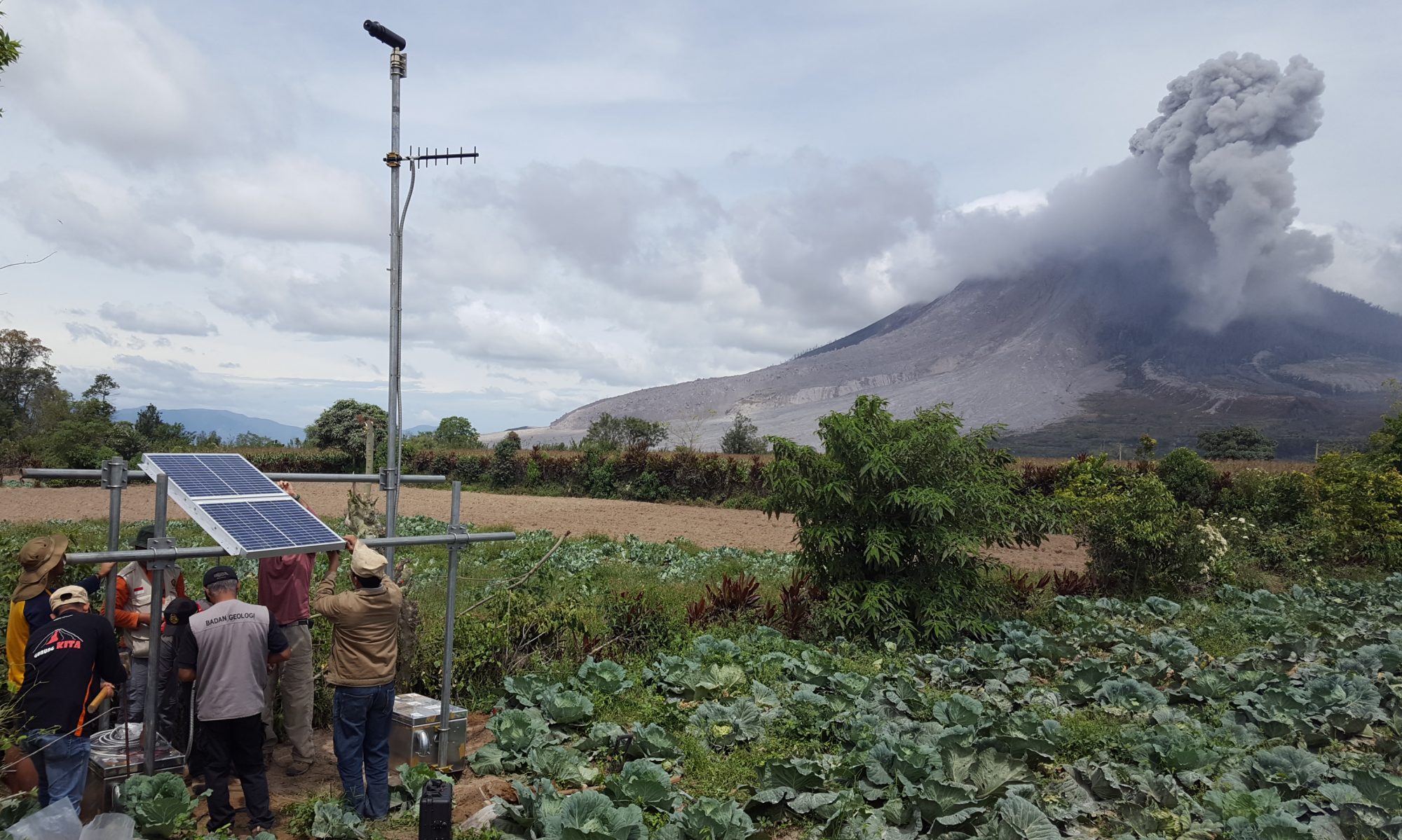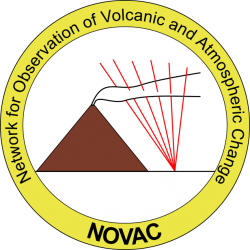Project Partners
NOVAC community is composed of partners from Asia, Europe, Africa, Latin America and USA, with expertise in volcanology, spectroscopy, atmospheric chemistry, satellite monitoring, volcano risk assessment and operation of volcano observatories. The most recent workshop held in Arequipa in April of 2018 was attended by 42 participants from 20 countries including Peru, United States, Argentina, Chile, Colombia, Costa Rica, Ecuador, El Salvador, Germany, Guatemala, Iceland, Indonesia, Mexico, New Zealand, Nicaragua, Papua New Guinea, Philippines, Singapore, Sweden, and United Kingdom.

List of Partners
| Chalmers University of Technology, Sweden | |
| The optical remote sensing group from Chalmers University of Technology has a long experience in applying spectroscopic methods to environmental monitoring and research including research related to stratospheric ozone depletion, urban air chemistry, biogenic climate gas emissions and industrial emissions. This group focuses on instrument development, instrument installations, scientific training of observatory personnel, development of data communication and archiving routines, promotion of the network and development of an internet interface. It is one of the main groups. | |
| Heidelberg University, Germany | |
| The atmospheric group from Heidelberg University has more than 15 years of experience in: Tropospheric chemistry of free radicals. Spectroscopic measurements of atmospheric constituents, in particular of halogenoxides, and other free radicals. The group is one of the inventors of the DOAS technique and continuously developing improved algorithms and new applications for the technique. It focuses on instrument development, instrument installations, scientific training of observatory personnel, development of data communication and archiving routines, promotion of the network and development of an internet interface.It is one of the main groups. | |
| Belgian Institue for Space Aeronomy (BIRA-IASB) | |
| BIRA-IASB has been involved for many years in atmospheric research activities aiming at the long-term monitoring of the atmospheric composition using ground-based, balloon-borne and satellite-based techniques. Since early nineties it has been closely associated to the development of the Network for the Detection of Stratospheric Change, both as data provider through design and operation of several NDSC-qualified instruments, and through contribution to the NDSC Steering Committee. BIRA-IASB is currently co-chair of the NDSC UV-Visible Working Group as well as the NDSC Satellite Working Group. | |
| University of Cambridge, United Kingdom | |
| The Cambridge Volcanology group has an unsurpassed experience in remote sensing of volcanic gas emissions and their geophysical relevance worldwide. His major task in the project is to be responsible for the local exploitation of data from Nyiragongo/Nyamulagira volcanoes, and to support the volcano Observatories with interpretations and advice whenever needed, to guarantee a full exploitation of the potential of the technique on all scales. | |
| IFM-GEOMAR Research Center, Germany | |
| The Magmatic and Hydrothermal Systems group (formerly Department of Volcanology and Petrology) has more than 15 years experience in volcanology, focussed on how volcanoes work. Main research topics include geochemsitry and largescale tectonic processes, and evolution of volcano-magma systems. | |
| Institut de Physique de Globe, France | |
| The Volcanology Group, at IPGP in Paris, provides a focus for scientists from a wide range of disciplines, including field volcanology, geochemistry and geophysics. It has experience in different fields of volcanology: fluid dynamical aspects of volcanic eruptions, field volcanology, magmatology of basaltic and andesitic systems, study of degassing processes, and geophysics. | |
| Istituto Nazionale di Geofisica e Vulcanologia, Catania, Italy | |
| The INGV Catania geochemistry group has performed routine measurements of the SO2 flux emitted from Mt. Etna, Sicily since 1987. It is therefore the most experienced group for volcano remote sensing in Europe, particularly with regard to data interpretation during volcanic eruptions, and integration with other geophysical datasets. | |
| Universidad Nacional Autonoma de Mexico, Mexico | |
| The Departamento de Vulcanología of the Instituto de Geofísica at UNAM has become a leading group in Latin America during the last decade and is formed by nine senior scientists and six technicians. These scientists have witnessed and studied several eruptions of the last decades in Mexico such as the eruptions of El Chichón volcano (1982), Volcán de Fuego de Colima (the most active volcano in Mexico), Evermann volcano (1993), and Popocatépetl (since 1994). | |
| Instituto Nicaragüense de Estudios Territoriales (INETER), Nicaragua | |
| INETER is the leading Geosciences Institute in Nicaragua. INETER´s Department of Geophysics is responsible for seismic and volcano monitoring and early warning. Volcano monitoring is carried out by means of digital seismic stations, webcams, temperature measurements, regular visits to the active volcanoes. |
|
| Observatorio Volcanologico y Sismologico de Costa Rica, Costa Rica | |
| The volcano geochemistry group has more than 20 years of institutional experience in the field of volcanic fluids. The group performs routine chemical analyses of magmatic gases from fumaroles, crater lakes, acid rain and hot springs. | |
| Instituto Colombiano de Geologia y Mineria, Colombia | |
| INGEOMINAS is the governmental institute in charge for monitoring and research of geological hazards in the colombian territory. The group of physicochemistry of geogases has more than 15 years experience in research and monitoring of volcanic gases. The main research and monitoring activities include 14 active colombian volcanoes, specially its fumarole gases, soil gases and dissolved gases in waters of thermal springs and volcanic lakes. | |
| Servicio Nacional de Estudios Territoriales, El Salvador | |
| Salvador, SNET is the national institution responsible for the study and research of natural phenomena, processes and dynamics of nature, the environment and society, which have a direct relation to the occurrence of disasters. | |
| Observatoire Volcanologique de Goma, D.R.Congo | |
| This group monitors and researches on active volcanoes of the Virunga range (Nyiragongo, Nyamulagira) and on regional seismology of the Kivu rift. | |
| Instituto Geofisico de la Escuela Politécnica Nacional, Ecuador | |
| The Instituto Geofisico (Departamento de Geofísica) of the Escuela Politécnica Nacional -IGEPN- is the official institution for the monitoring and carrying out research of the volcanic and seismic phenomena in Ecuador. Three decades of experience in maintaining an active program of real-time instrumental monitoring across the national territory as well as in publishing scientific and popular literature have been honored with much recognition, including the prestigious Sasakawa Award of the United Nations for the world’s best program in the mitigation of natural disasters for 1992. | |
| Instituto Nacional de Sismologia, Meteorologia e Hidrologia, Guatemala | |
| The National Institute of Seismology, Volcanology, Meteorology and Hydrology -INSIVUMEH- was created according to presidential agreement dated March 26th 1976 as part of the Communications and Public Works Ministry. The institute has as objective to carry out technical and scientific activities regarding permanent and sustained data collection through observations and periodic and continuous monitoring as well as the execution of projects and consultancy to governmental and private institutions, NGOs, universities and educational centres of the country. It also acts as scientific adviser of the government in the event of natural disasters. | |
| Massachusetts Institute of Technology, USA | |
| The Department of Earth, Atmospheric and Planetary Sciences at the Massachusetts Institute of Technology has broad intellectual horizons that encompass the solid Earth, its fluid envelopes, and its diverse neighbors throughout the solar system and beyond. Research is done on the global-scale systems of the Earth’s atmosphere, oceans, mantle and core, as well as a wide variety of smaller-scale systems, which include severe storms, ecosystems, petroleum reservoirs, hydrological systems, volcanoes and active faults. | |
| University of Maryland Baltimore County, USA | |
| The Joint Center for Earth Systems Technology (JCET) at the University of Maryland Baltimore County (UMBC) is home to the Ozone Monitoring Instrument (OMI) – Total Ozone Mapping Spectrometer (TOMS) Volcanic Emissions Group.Until 2000 the group was based at NASA’s Goddard Space Flight Center (GSFC) and strong links are maintained with GSFC. Members of the team made the first measurements of volcanic SO2 emissions from space in 1982 using UV data from Nimbus-7 TOMS, and since then the TOMS database of volcanic SO2 production has been extended to cover over 25 years (1978 – present). | |
| Istituto Nazionale di Geofisica e Vulcanologia, Palermo, Italy | |
| The INGV Palermo geochemistry group has a long experience in geochemical studies of Italian volcanoes, in specific Vulcano and Stromboli. They have joined the NOVAC project with their own funding and installed a NOVAC instrument on Vulcano in March 2008. | |
| USGS Volcano Disaster Assistance Program, USA | |
| Based out of the USGS Cascades Volcano Observatory in Vancouver, Washington, the group consists of approximately 20 geologists, geophysicists, and engineers. It assists foreign partners in volcano monitoring and empower them take the lead in mitigating hazards at their country’s threatening volcanoes. | |
| Rabaul Volcano Observatory, Papua New Guinea | |
| The Rabaul Volcano Observatory (RVO), established after the 1937 eruption at Rabaul, is responsible for monitoring the activity of the 16 active and over 20 dormant volcanoes spread along three volcanic arcs throughout Papua New Guinea. More than 150 eruptions have been recorded in the last 200 years. | |
| Centre for Volcanology and Geological Hazard Mitigation, Indonesia | |
| The CVGHM (known in Indonesia as PVMBG, Pusat Vulkanologi dan Mitigasi Bencana Geologi) is responsible for volcanic, seismic, and landslide risk mitigation in Indonesia. The CVGHM prepares policies, norms and procedures related to geological hazards in the country. It conducts independent research on volcanoes in Indonesia, and provides advice to the communities in the vicinity of active volcanoes regarding engineering and urban planning. | |

